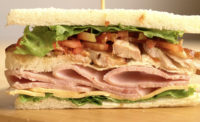Breakfast took a big hit during the pandemic due to the altered morning eating routine for many people who switched to working remotely during the pandemic. Foodservice operators are turning their attention to breakfast once again, according to foodservice market research firm Technomic. Here are a few “micro trends” from foodservice operators finding creative uses for breakfast proteins in their morning meal creations:
Wood-fired eggs — smoked bacon, wood-fired egg, cheddar cheese, and house biscuit (Chop Shop in Park City, Utah)
Marbleized eggs breakfast sandwich — house sage sausage patty, marbleized egg, raclette-pimento cheese, and squash toast (Valentine in Phoenix)
Nontraditional bacon — duck bacon, egg, and cheese sandwich featuring duck bacon, scrambled eggs, cheddar cheese, and tomato jam (Jack’s Wife Freda in New York City).
Stepping away from the culinary cutting edge, here are some breakfast protein formulation basics, according to Bruce Armstrong of LifeSpice Ingredients:
What are some key considerations for crafting the right flavor profiles for staple breakfast proteins such as sausage and bacon?
Bruce Armstrong: Salt is most important key. Proper salt level is critical for correct flavor. Secondly is balance of sweetness with sugar. Because of the high home cooking temperature sugar will minimize burning in both bacon and sausage. Sugar is the only sweetener in bacon. In pork sausage, a small level of dextrose at 0.10% to 0.15% will give the home consumer visual browning to help in determining proper cooking finish. Sausage base flavor is black pepper with about 4 ounces per 100 pounds meat. There is regional preference for amount of sage. Northeast has low tolerance for sage. Usage level is from zero to 0.5 ounce per 100 pounds. This tolerance or flavor preference increases through the Southeast and South. The Southeast has a preference for 1- 2 ounces of sage per 100 pounds. This increases to 4 ounces in Louisiana and Texas. Historically, sage was originally used to cover rancidity in pork sausage. The Northeast is cooler, thus less pork rancidity. The South with higher temperatures had more rancidity. Thus, the variation in sage preference.
Are there different considerations when formulating link vs. patty sausage?
Bruce Armstrong: Link sausages traditionally have finer spice particulates. The casing amplified the spice particulates and consumers objected. Link sausage is most often a mild flavor. Patty sausage presented nicely with spice particulates. Patty sausage is most often presented in a mild version. Additionally, patty sausage will be presented in hot versions with red pepper particulates visible to indicate the higher heat level. Hot is an objective term. Hot versions in the South mean it.
How has the trend toward fewer preservatives/shorter ingredient decks impacted formulations for breakfast proteins?
Bruce Armstrong: Ingredient declarations with fewer words are important. The major change in preservative for pork sausage has been removing BHA, BHT, and citric acid from the formulation and thus the label. Obviously, these are chemical compounds. The industry has moved to oleoresin rosemary as a replacement. It is natural and labels as natural flavor. It has proven to be an excellent replacement.
How do breakfast protein formulations differ for fresh vs. frozen, precooked product, etc.?
Bruce Armstrong: There is not much difference between fresh and frozen. A large portion of breakfast sausage is shipped frozen. This allows consistent temperature handling during shipment. Precooked sausages have right amount of dextrose to give product a cooked appearance. This allows the product to be finished on a grill, in an oven, or in microwave with correct visual appearance. The flavor profile of sausage is similar for all these products.
What are some current “trendy” flavors for breakfast sausage and bacon?
Bruce Armstrong: Coating bacon with seasonings is an easy way to create flavor variations. Most common is black pepper. The pumped bacon is coated on the protein side with a mix of black pepper and sugar. The seasoning is locked into the protein during smoking and cooking. This remains with bacon during slicing. Variations on this include Apple Pie Spice — a mix of sugar, cinnamon, and clove; Roasted Garlic, a mix of sugar, granulated roasted garlic, and granulated toasted onion; and Chipotle Pepper, a mix of sugar, chipotle pepper, and black pepper. Any coarse seasoning will work. The best point is the flavor can be applied to one bacon belly or multiple bellies. Breakfast sausage has a traditional flavor of black pepper, sage, and red pepper. Having said that, additional flavors such as thyme, chipotle pepper, and other spicy flavors will create new flavors.

.png?height=96&t=1647275041&width=96)


